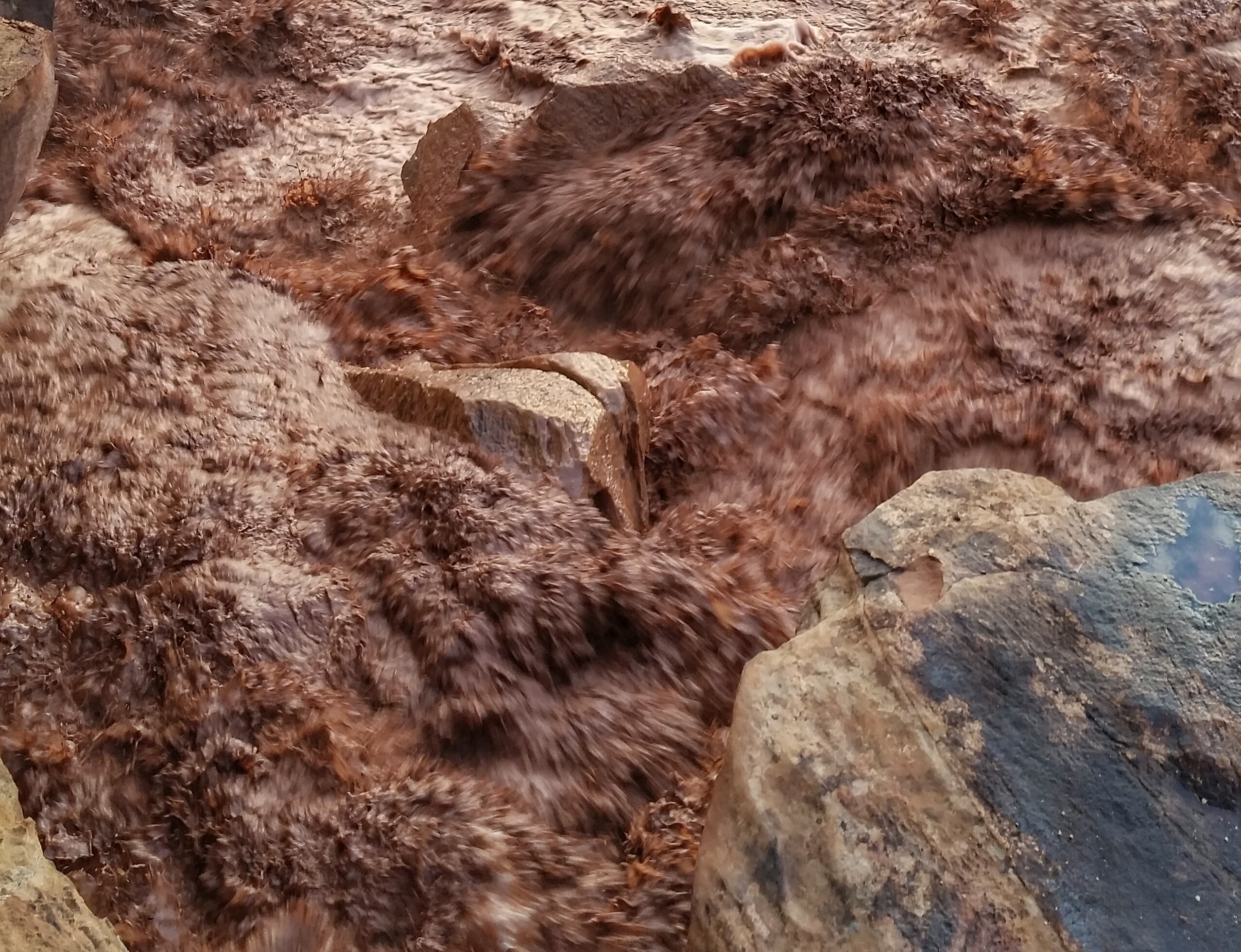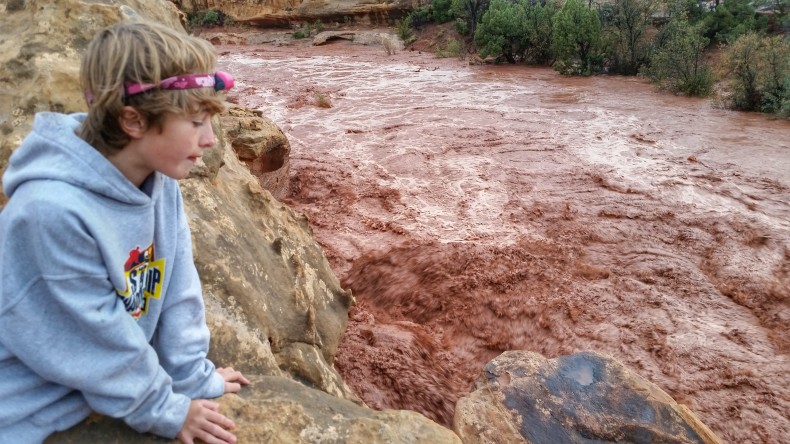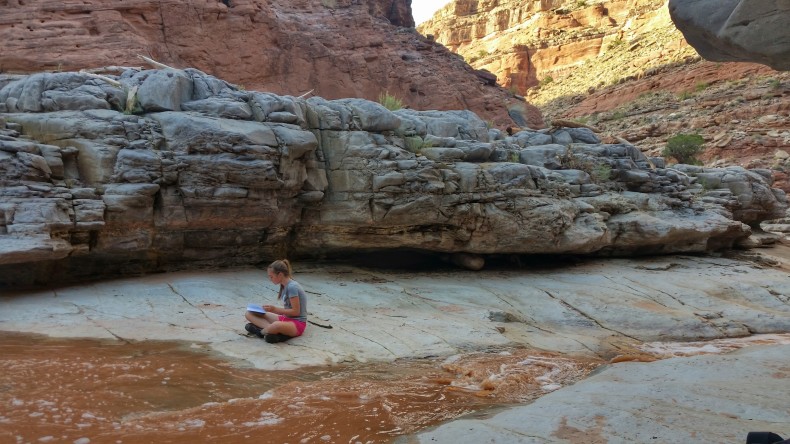Snow has been heavy this winter and spring where I live in the Southwest, and sunny days are coming, meaning the white is about to turn to water and desert rivers will soon be raging. Whenever water starts to move I get excited. How could I not? It’s like an animal come to life, nosing its way through terrain. Even a car being washed up the street catches my attention as I follow the first finger finding its way down a curb. Even better if it comes out of the sky and roars across the land foaming. With that in mind, this post originally came out in October of 2015 and I hope it makes you want to chase the water, or at least admire it when it suddenly appears.
The picture above I took may look like nothing but chaos and you may be right. It is a flash flood in southern Utah and I was safely standing on a ledge above it. I was absorbed by the galling roar and the smell of the desert funneled by intense rainwater to a single point. Watching this with the naked eye is dizzying, though I could stay for hours and stare at physics folding on itself, fluid dynamics torn up by its roots. But it would not last for hours. Later that day, the flood would have dropped ten feet. The show would be all but over.
In the desert, however, the show never ends.
I was on NPR’s Morning Edition talking about the nature of flash floods after 16 people were killed in two different southern Utah flood events in one day. It’s hard to talk about something you love when it just ended lives. Many of the 16 were children.
Still, I can’t avert my gaze. I can’t help but inch my way closer. During this last wave of floods, I was out with a group of 7th and 8th graders from my children’s school backpacking in the wild, tangled canyons of southern Utah. Hearing of weather alerts and flash flood warnings, some parents were hesitant, to say the least, that we were going ahead. But we were on the other end of the spectrum from those who died. We were looking for floods, not trying to get away from them. We reveled in water, the girls in the group singing songs one morning about it, like prayers, like hymns, not like those who must have been lost in terror wondering what hit them.
There’s an art to floods. They leave behind sculpture galleries of boulders and fluted bedrock, woody debris woven like basketry around the battered trunks of trees. In this sandstone desert, have you ever walked through what is called a slot canyon? The bedrock walls are smooth and shaped like eggshells, two sides of the canyon close enough you can touch them at the same time. You are walking through a hydrology equation, the chaos of floods rendered in elegant form. This is what the bedlam of a flood creates. Within the madness is a delicate and irreducible order.
We were wet. Rain dripped through our hair. I led kids out to edges where we could see muddy, frothy cascades. Canyon floors swallowed their floods, musical slot canyons turned into monsters below us. Rocks snapped and pounded as kids shouted, “Holy shit!” Which in particular I like to hear.
One day, we gathered under an overhang as another storm cell dropped in on us. The desert canyon suddenly looked like Venezuela, waterfalls coming down everywhere. The shelter we’d chosen was also home to a row of pre-Columbian cliff dwellings. If they survived the last 800 years, we’d do well for the afternoon. We gathered like owls in the dry nook while sheets of water fell before us. Kids noticed right away some of the water coming down was muddy, some clear. They were becoming aware of how the land works, what rain ran clean off of stone and what came through earth, plucking out its parts. We were as safe as you could be, balcony seating for the event of the desert.
When the floods fly, you see the purpose of the landscape around you. The desert is a blueprint of moving water. We watched every wash and pouroff come to life. Dark streaks on the underside of boulders became channels. Geography revealed its purpose. It was all about water.
I know a woman who has, as a forensic scientist, dealt with the bodies of flood victims. She told me of the face of a six-year-old girl. Surgically removed from the girl’s head by a flood, there were no bones or teeth. It was only a face, limp as a rubber mask. The rest of the body had been unharmed, protected, she said. This seemed like something she had been waiting to tell somebody. In the wrong context, it may have seemed trivial or too grotesque for conversation, but when we talked about it, she was enchanted by what it proposed. Something was hidden in the water. The water meant whatever it had done. There was nothing personal to the victim, no vendetta. It was just that water was too powerful for life to withstand, and within that power was precision, as if choices were being made, she said. The final word of water had been revealed by its own fierceness.
Storms eventually roamed away, leaving us with clear skies. We carried our camp on our backs into winding canyons where the floods were reduced to red-brown threads of flowing water. The roar had been turned to mumbles and chatters of a stream, the talkative language of water dancing down the canyon. Debris gathered high overhead and the stone was smooth, polished by what had been a wild and terrible force only days before.
Death and beauty lie this close together.
You do have to be careful, even on these sunny days. A storm can hit many miles away and come on you like a freight train. But I knew these canyons and could read the lay of storm systems. I watched the skies, smelled the wind, listened for a chundering bellow coming from upstream. We were in the clear. The desert went back to being itself, still, hard and mostly waterless. But in the bottom ran a reminder. The voice of water sang and burbled. It told us why all of this was here.
Photos and video: Craig Childs



I have experienced such floods; the raging water that seems so angry and so relentless in its pursuit of exhaustion. I have watched cars as they are ripped off the pavement and float away. I have seen a truck pulling a horse trailer with two horses in it get swept downstream and overturned all because the driver thought he was stronger and smarter than Mother Nature – by some miracle the horse were both saved. These raging floods are not something a human should want to challenge and yet we do and some of us die doing it. Thank you, Craig, for putting this angry side of MOther Nature into such beautiful and meaningful words. Thank you for sharing this side of nature with a group of children. May no child be left inside.
“The water meant whatever it had done.” “the raging water that seems so angry.” The earth is never angry nor sad nor generous nor any other human characteristic. When we tiny humans pretend that the earth is just like us, we may briefly calm our fears. Our species cannot stand to have anything bigger than it. And, that is precisely what has allowed us to steadily destroy this miraculous planet upon which we are privileged to live. If we can stand to experience not being the center of things, we might finally learn something that would allow us to stop destroying each other, and everything that isn’t us. We break my heart.
Thanks for sharing this story with us, Craig! Gazing through such a window to see water at work is a valuable gift you’ve given to these children–with awe, a sense of wonder, and respect the likely outcome. On bird walks that I lead for kids, the facade of nature = somnolence gets stripped away when a Cooper’s Hawk slashes in to make off with a songbird. Kids love a front row seat to the kind of drama you’ve likewise shared with them, and they are now better informed and their lives enriched as a result. Your writing is always inspirational…
Happy to see that you are still writing about our crazy wild wilderness . We too travel out to see the beauty of it all but cannot put it into words like you do. So we take photos to capture the wilderness. Your words put me along side the flood. Thank you for sharing.
Thank God for writers like you, Craig, leading children into the landscape to share the beauty and the wild wonder.
If you can walk, you can do the same. Any of us can. Anywhere. There are stories all around us.
Mary, I believe that to pretend the earth is not like us is to pretend we are not like it, and we artificially separate ourselves and say we are not of it. That, I believe, is the most dangerous thing we could do.